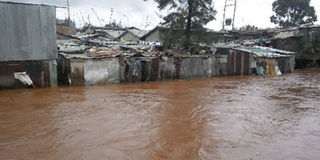Nairobi rivers pose health, safety hazards

Photo|STEVE WAITHANJI|NATION
Mathare residents were affected by the flash floods that wrecked the area on May 13, 2012.
A century ago, Nairobi was a tented camp for the Kenya-Uganda railway workers.
It had cool weather, clean drinking water from four main rivers – Ngong, Nairobi, Mathare and Mbagathi – creating a bubbling ecosystem in which plant and animal life thrived.
Today this ecosystem has been destroyed by human settlement. The four rivers still flow through Nairobi but, because of a century-long pollution, many people mistake them for an open sewerage system.
Yet, as has been witnessed in the last few weeks, the rivers are very much alive with the potential to claim their encroached territory with devastating ruthlessness.
Last Saturday night, Mathare river burst its banks. One man drowned in the raging waters. Slum dwellings on the river’s course were swept away, leaving more than 300 people homeless. (SEE IN PICTURES: Mathare flash floods)
What was surprising to the Mathare residents was that it was not raining in the area at the time of the flooding. The flood waters came from Kiambu district, which is the source of tributaries that drain into Mathare river.
Over the last few years, the government, supported by bodies such as the Unep, has put in efforts to clean up the rivers beginning with Nairobi river.
According to Nema’s director of compliance and enforcement, Mr Benjamin Langwen, the 40km stretch of Nairobi river from the source to the city has been covered.
“This area covers the source in Ondiri swamp to the city centre. We have dealt with all the discharge points as well as reclaimed the riparian area.
For the first time in decades, aquatic life has been spotted,” Mr Langwen told the Sunday Nation. The biggest challenges to the cleanup are the many informal settlements along the rivers.
Ngong river runs through the Kibera slum which, despite its large human population, has no sewage and solid waste disposal system.
It also passes through the Industrial Area where some industries discharge their waste into it.
While Mr Langwen says these discharge points were closed, the river runs through Mukuru Kaiyaba and Mukuru kwa Njenga, both populous slums, whose residents discharge their waste into the river.
Nairobi river cuts through Grogan area into Gikomba, a densely populated area with both shanties and light industries on the river banks. It also meanders through the sprawling Kiambiu slums.
And Mathare river flows through the sprawling Mathare slum, where sewage and solid waste disposal systems are non-existent.
When he was minister for Environment, the late John Michuki had proposed that all people living in the riparian area be relocated, saying this was the only way the rivers in the city could be reclaimed.
Land had been identified in Njiru and Mwiki areas where people living in the informal settlements along the river were to be relocated. The proposal was roundly rejected by the residents.
They said that, as poor people, they walk to work in the city centre or Industrial Area. Relocation, they argued, would cut off their livelihoods. The idea was quietly dropped.
According to Mr Langwen, the alternative to relocation is provision of proper housing with drainage and sewage as well as solid waste disposal systems.
Peter Otieno lives in a mud-walled and iron roof single room in Majengo, not far from Nairobi river. He pays Sh500 in rent per month for the room he lives in with his wife and three children. It is a walking distance to Grogan where he works as a mechanic.
“If the government was to put up modern housing, rent would definitely go up beyond my reach. The cost of water would also go up. We would be forced to move further away from the workplace.”
Mary Wambui, who sells snacks on a footpath in Gikomba, says she had always believed Nairobi river was part of the city’s drainage system.
“It was only after the cleanup exercise started that most of us realised this is a river. We were amazed when we saw street boys fishing between Kariokor and Globe Cinema roundabouts,” she says.
Besides industrial and domestic waste that is discharged into the rivers, other effluent comes from agricultural activities and car wash runoff water.
“We have small-scale farming where chemical fertilisers are used. When it rains, some of the fertiliser and dangerous chemicals are washed into the rivers.
“In the long term, people living downstream will accumulate dangerous metals such as lead in their blood if they use the water to wash vegetables,” says Mr Langwen.
The boreholes within the Nairobi river basin are also in danger of contamination. Nema says some harmful elements in the rivers will eventually seep through the layers of soil into the ground water system.




